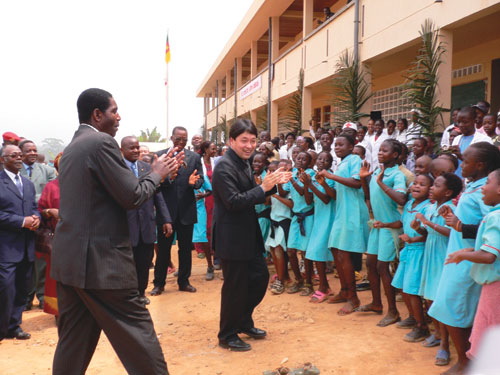Japan's Official Development Assistance White Paper 2005
Main Text > Part II ODA DISBURSEMENTS IN FISCAL YEAR 2004 > Chapter 2 Details and New Policies about Japan's ODA: Striving for Further ODA Reforms > Section 3. Assistance for Each Region > 4. Africa (Sub-Sahara)
4. Africa (Sub-Sahara)
Japan's bilateral ODA to the African region in 2004 was approximately US$646.97 million, 10.9% of total bilateral ODA.
Africa is a region in which issues such as serious poverty, conflicts, hunger, infectious diseases including HIV/AIDS , and accumulated debt are concentrated. In recent years, the importance of African development issues has been recognized, and is increasingly gaining the attention of the international community. Most discussions concerning development in various international conferences since the United Nations ( UN ) Millennium Summit in 2000 have taken up the various issues faced by Africa, including development. Anticipating this trend, Japan has been actively taking the initiative within the international community in providing development assistance to Africa since early 1990s. To reawaken the interests of the international community in African development, which was waning with the end of the Cold War, Japan held the First Tokyo International Conference on African Development ( TICAD ) in 1993, and the TICAD II in 1998, to advocate the importance of ownership of African countries and partnership with the international community. Such Japanese initiatives toward African issues have led the international community to enhance its efforts on African development. Moreover, on the occasion of the G8 Kyushu-Okinawa Summit in 2000 for which Japan was chair, presidents of South Africa, Nigeria, and Algeria were invited to Tokyo to hold talks with the G8 leaders. Since then, dialogues with African leaders have taken place at every G8 summit, and at each summit meeting African issues have been raised as one of the main topics on the agenda. Specific cooperation efforts are expanding, including the G8 Africa Action Plan, which was adopted at the G8 Kananaskis Summit in 2002. Furthermore, at the G8 Gleneagles Summit in July 2005, various new assistance measures to Africa were agreed, based on commitments made by the G8 thus far and the efforts of Africa itself. In addition, African countries have acknowledged the importance of their ownership, and have been advancing specific actions such as the establishment of the NEPAD and the African Union ( AU ).
Chart 29. Japan's Assistance Disbursements in the African


Parliamentary Secretary for Foreign Affairs Itsunori Onodera visiting the Sangmelima Primary School built through Japanese grant aid cooperation (Cameroon)
At TICAD III in September 2003, Prime Minister Junichiro Koizumi announced Japan's initiative for assistance for Africa based on the three pillars of "human-centered development," "poverty reduction through economic growth," and "consolidation of peace." He also announced that grant aid of US$1 billion would be extended over five years in the BHN sectors such as health and medical care including measures against HIV/AIDS, education, water, and food assistance. At the same time, Prime Minister Koizumi revealed that Japan's assistance to Africa would place emphases on the South-South Cooperation and the perspective of human security. The TICAD Asia-Africa Trade and Investment Conference ( AATIC ) was held in November 2004, and there were discussions on specific methods of African development via expansion of trade and investment, with focused attention placed on the situation of trade and investment between Asia and Africa, which is growing at a rapid rate. 47 The TICAD process over the past ten years has been highly appreciated by Africa, which has expressed a strong desire for the continuation of this process. Based on there achievement, Prime Minister Koizumi announced at the Asia-Africa Summit in April 2005 that Japan would host TICAD IV in 2008.
Through the TICAD process, Japan has provided various forms of cooperation to African countries such as agricultural development, promotion of trade and investment, social and economic infrastructure development, and humanitarian and reconstruction assistance in conflict-affected regions, which are essential for Africa's economic growth. Ahead of the MDGs, Japan announced at the TICAD II in 1998 that it would provide US$90 billion to the water, education, and health and medical care sectors. Over five years until TICAD III in 2003, Japan helped to develop access to clean water for 4.6 million people, develop access to education for 2.6 million children, and provide health and medical services to 240 million people, placing high consideration on the perspective of human security. Regarding South-South Cooperation, Japan is conducting third-country training to neighboring countries by utilizing cooperation bases within Africa. At the same time, Japan promotes South-South Cooperation by implementing technical cooperation jointly with other Asian countries. In particular, the Asia-Africa Cooperation, which utilizes the experiences gained by Asian countries that have achieved growth through the support of economic cooperation provided by Japan, has been regarded highly as unique cooperation. Under this cooperation, specific and distinctive projects are being implemented such as the development and dissemination of NERICA, and the promotion of private trade and investment through the Africa-Asia Business Forum and other means.
Moreover, as conflicts are a major hindrance against development in Africa, it is extremely important to provide assistance aimed at the consolidation of peace. Therefore, Japan has been actively providing assistance in this area. (See 4 (4) of Part II, Chapter 2, Section 2 for peace-building assistance to Africa.)
Furthermore, 34 of the 42 countries in the world which are designated as heavily indebted poor countries (HIPC) are concentrated in the African region. To these countries, Japan is providing the maximum level of debt relief assistance under the framework of Expanded HIPC Initiative debt relief. (See 2 (7) of Part II, Chapter 2, Section 2 for debt-related issues.)


 Next Page
Next Page